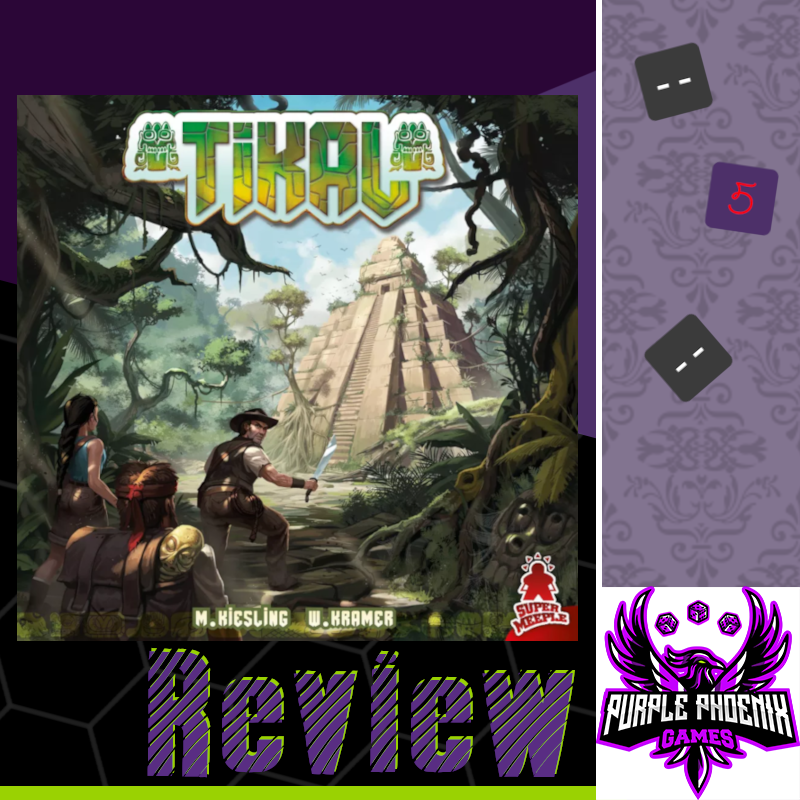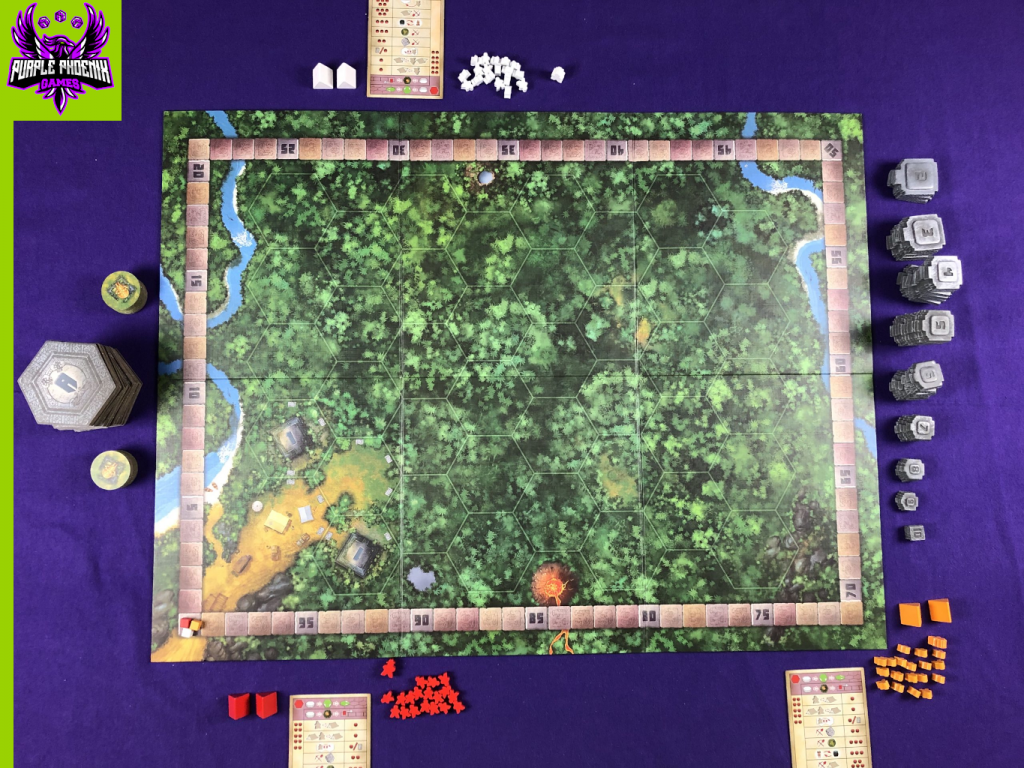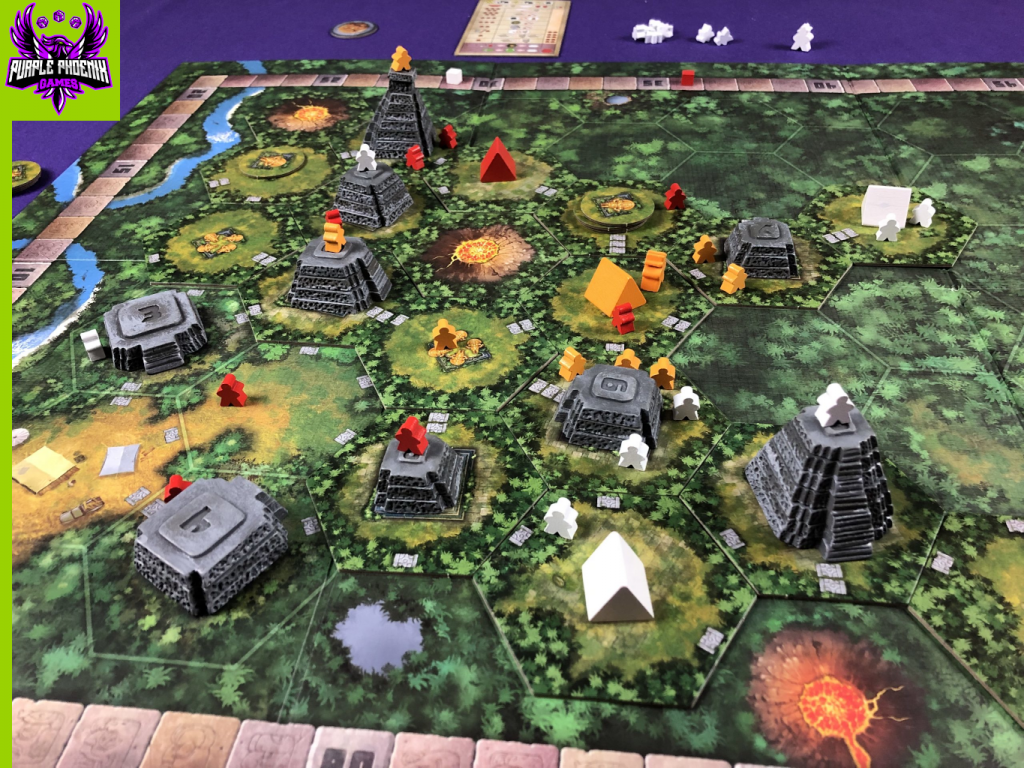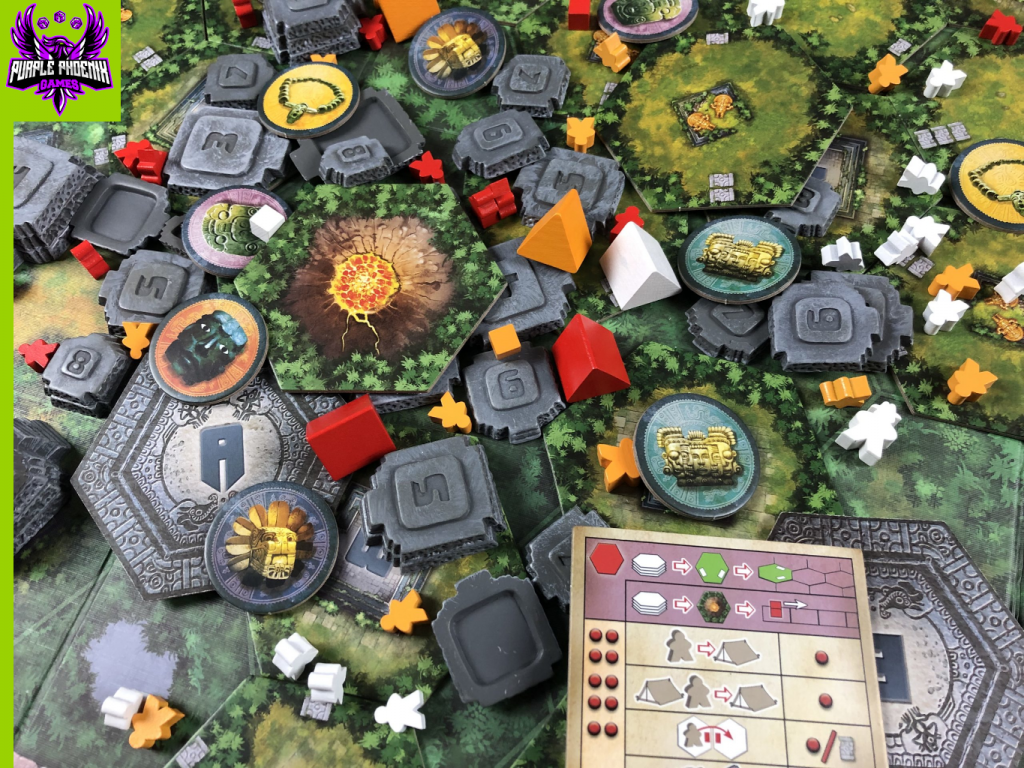
I enjoy going to my FLGS simply to just look at games. I may not have an intention to necessarily buy one each trip, but I love seeing all the different box art, titles, themes, and more. In several stores that I have visited, I always saw copies of Tikal on the shelf. The box art caught my eye, and I finally decided to actually take it down and check it out. The game pictures and description seemed intriguing, and since I was already drawn to the art style, I figured it was probably time for me to finally just buy it – and here we are now. Was the allure of Tikal founded? I’ll tell you now: Yes.
| Tikal (2021) | Super Meeple |
| 2-4 players | 90 minutes |
| Ages 10+ | BGG Weight – 2.79 / 5 |
Tikal is a game of tile placement, grid movement, area majority, and action points in which players take on the roles of Explorers who are working to excavate ancient temples of Tikal and unearth hidden treasures. Over a series of rounds, players will take turns placing new tiles, exploring temples, uncovering treasure, and setting up camps. The more temples you explore and treasures you recover, the higher your Prestige will be, and the player with the most Prestige at the end of the game is the winner!
To setup for a game, place the board in the center of the table. Sort and shuffle the stack of Terrain tiles in their listed order, and set the Temple Floors to the side. Shuffle the Treasure tokens and set them to the side as well. Each player receives a Player Aid, a scoring marker, Explorers, Expedition Leader, and Camps in their chosen color. Select a starting player, and the game is ready to begin. Each player turn is comprised of two steps: Play a Terrain Tile, and Spend Action Points. At the start of your turn, you will draw a new Terrain tile from the stack, and place it on the board following the placement rules. Once the new Terrain is placed, you have a total of 10 Action Points (AP) to spend, performing various actions. The different actions cost different amounts of AP, and you can perform as many actions each turn as long as you have AP to spend. An important note – AP do not carry over between turns, so you have to use it or lose it.

The actions you can take on your turn are as follows: Play a new Explorer, Move an Explorer between Camps, Move an Explorer to an adjacent Terrain tile, Clear a new Temple Floor, Dig up a Treasure, Trade a Treasure, Set up a Camp, or Place a Guardian on a Temple. On your turn, you may spend AP to play Explorers to the board. When adding Explorers, they are played either to the game-start Base Camp, or any of your personal player Camps you have set up. You can choose to spend AP to move your Explorers between your camps, thus getting Explorers across the board quickly. To move to an adjacent Terrain tile, you will spend AP as listed on the path connecting the two tiles – anywhere from 1-6 AP.
The next action, Clearing a Temple Floor, is one of the most important elements of the game. When a Terrain tile with a Temple is played, you now have the opportunity to explore it. The Temple will have a numerical value printed on it, ranging from 1-6, and that number represents the current Prestige value of the Temple. To Clear a Temple Floor, you must have an Explorer on the corresponding tile, and you will spend a total of 2 AP to perform this action. Take one of the Temple Floors from the supply (marked with the next ascending number) and add it to the current Temple. For example, if you clear a 2 Temple Floor, you will now add a 3. When it comes time to score, this Temple will now be worth 3 Prestige.
When revealed, certain Terrain tiles will have Treasures buried on them. You can choose to spend AP to dig up a Treasure. Collecting matching sets of Treasures will earn you big Prestige, so this is a viable strategic route to success. If an opponent has a Treasure you need, you can trade Treasures, following certain restrictions. To Set up a Camp, you must have an Explorer on a Terrain tile with no Temple or Treasures. Add one of your Tents to this tile, and on future turns you can now add Explorers to this Camp instead of the game-start Camp.
The final option, Place a Guardian on a Temple, is the best way to secure your Prestige. When the scoring phases come around, players will earn Prestige for Treasures owned and for Temples they control. In order to control a Temple, you must have the majority of Explorers on the tile. So if I have 4 Explorers on a Temple, but my opponent has 5, they will get those Prestige points and I will get nothing. In order to guarantee Prestige for yourself, you may spend AP to place a Guardian on a Temple. To do so, you must currently be the player with a majority presence on the Temple. You will place one of your Explorers on top of the Temple, and remove your other Explorers from the game. This Temple is now controlled by you, and only you can earn points for it during the scoring phases. You are only ever allowed to have 2 Guardians, so chose your placements wisely.
Throughout the game, there will be 3 scoring phases before the game end. When a scoring phase is triggered (a Volcano tile is drawn from the stack), each player will have the opportunity to spend 10 AP before scoring their current Prestige points. So basically, everyone gets a quick turn before you score points. You score your Prestige immediately after you spend your 10 AP, so the tile majorities, Temple levels, Treasures uncovered, etc. could potentially change between every player and affect their scoring accordingly. Again, you will earn Prestige for sets of Treasure tokens collected, as well as Temples you control/have the majority presence. After a scoring phase, the game continues in player order as normal. The game goes on until the stack of Terrain tiles completely runs out. Each player will get one more chance to take a turn (Spend 10 AP) and add their final Prestige to their cumulative score. The player who ends the game with the most overall Prestige is declared the winner!

So that seems like quite a mouthful, but I promise the gameplay flows pretty smoothly overall. You just have a lot of options each turn. With options, comes strategy, and that’s probably my favorite thing about Tikal. The game board is literally changing with every turn, and your strategy must be strong, yet adaptable, in order to deal with unexpected changes. First thing to strategize about is your tile placement – where can you place a tile that’s most beneficial to you, but tricky for opponents to get to? Right off the bat, each turn starts with your strategy. And then when it comes time to spend your 10 AP, your strategy gets elevated even more. With so many action options each turn, you really have a chance to diversify your strategy. Obviously, clearing Temple Floors will get you lots of Prestige, but don’t sleep on those Treasure tokens. Get a complete set and it will earn you Prestige at every scoring phase. The more floors that are cleared on a Temple, the more Prestige it will be worth, and that kind of gets a push-your-luck element in this gameplay too. How many floors can you risk clearing without placing a Guardian and claiming it as your own? If you’re grinding on a Temple to get its Prestige up, and on their next turn, an opponent uses all their AP and resources to steal the Temple out from right under you?! There’s definitely a risk/reward element going on.
Another element of the gameplay that I really like is the fact that during a scoring phase, you score your Prestige immediately after finishing your turn, and not after everyone has gone. This gives all players an equal opportunity to earn Prestige, instead of making strategic moves that are counteracted by an opponent who acts later in the round. I feel like it keeps the scoring more even and fair, and that is a huge plus for me. The game does come with a set of Advanced Rules that add an element of auction/bidding for turn order into the gameplay. Players can bid on turn order by spending Prestige – so there’s a whole other strategy to think about! One component of the game that I really appreciate are the Player Aids, which list the available actions and their corresponding AP. They are clearly marked and easy to understand, and that helps the game flow well. The only downside overall that I see with Tikal is that 10 AP is kind of a lot, and the game does not offer any way to track your AP each turn. Not that it’s necessarily hard to just remember and count in your head, but sometimes when thinking about your actions/options and strategy, it would be easier if there were a component that tracked that for you. I may personally add a set of d10’s to this game to serve that purpose.
Since I already mentioned some components, let me touch on the rest. The game board and Terrain tiles, and Treasure tokens are all nice, chunky, and sturdy cardboard. I know this game will definitely stand the test of time. The Explorer meeples are smaller than your standard meeple, but they are relatively easy to manipulate in-game. The Temple Floors are nice resin tiles that definitely elevate the gameplay. They are nice and heavy, and they look thematically like ancient temples, and that just adds to the gameplay for me. Again, I wish there were some sort of AP tracker, but overall the production quality of Tikal is through the roof.
As you could probably tell from the scoring graphic above, I am definitely a fan of this game. I feel like the mechanics mesh really well together, the theme is fun, and the gameplay is unique. With so much going on, players who are prone to analysis paralysis may need extra time for their turns, but overall the pacing of the game is good. Admittedly, it does start out a little slow, but once the turns get going and more tiles are played to the board, it really takes off. I don’t think this is a game I would necessarily pull out with all gamers, but I have specific gamers in mind that I want to play this with. Based on the mechanics, I figured that I would like Tikal, but I wasn’t expecting to like it this much. It’s not quite in my Top 10, but with more plays, I could see it getting there eventually. I am so glad that I finally decided to give this one a chance, as it really blew me away. Purple Phoenix Games gives Tikal a prestigious 5 / 6.

